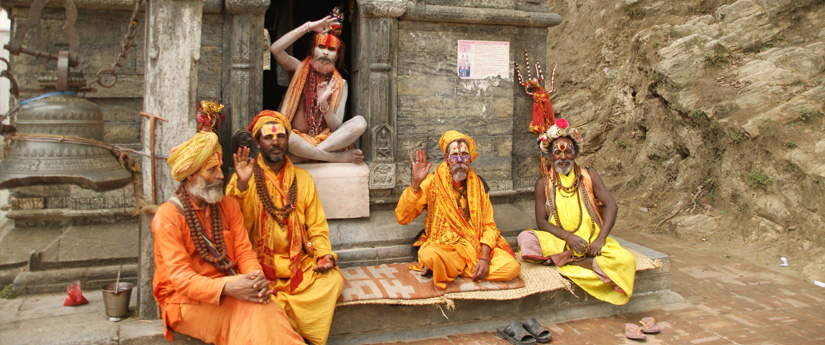
- Duration : 01 Days
- Max Height : 1400m
- Trip Grade : Tour
- Accommodation : Lodge/Hotel
- Transportation : Bus/Car
Trip Overview
The Buddhist temple of Swayambhunath situated on the top of a hill west of the city, is on the most popular and instantly recognisable symbols of Nepal. The temple is colloquially know as the 'monkey templ' after the large tribe of handsome monkeys which guards the hill and amuses visitors and devotees with tricks, including slinding gracefully down the double banisters of the main stairway to the temple. The roving monkeys quickly snatch up any offerings of food made by devotes and will just as quickly grab anything you may be carrying.
Boudhanath:
The Stupa of Bouddhanath lies 8 km east of Kathmandu. This ancient colossal Stupa is one of the biggest in the world, and the center of Tibetan Buddhism in the world.
Boudhanath :
The stupa of Boudhanath lies 8 km east of Kathmandu. The ancient colossal stupa is considered one of the biggest in the world. It stands on an octagonal base inset with prayer wheels and ringed by houses of lamas or Buddhist priests.
The stupa is believed to have been built by King Manadeva at the advice of goddess Mani Jogini. It has four pair of eyes in the four cardinal directions. The God is believed to keep on watching for righteous behavior and human prosperity.
Lumbini :
Lumbini, the birthplace of Siddhartha Gautam Buddha, the Shakya prince and the ultimateBuddha, the Enlightened One, is the pilgrimage destination of the world'' millions of people faithful to all schools of Buddhism. This nativity site identified by Indian Emperor Ashoka's comme–morative pillar .
The main attraction at the Lumbini remains the sacred Garden spread over 8 sq km and possessing all the treasures of the historic area. The Mayadevi temple is the main attraction for pilgrims and archaeologists alike. Here we find a bas relief of Mayadevi ,the Buddha's mother giving birth to him. Standing west to the Mayadevi shrine is the oldest monument of Nepal, the Ashoka's pillar .The pillar was ereced by Emperor Ashoka in 249 BC to commemorate his pilgrimage to the sacred site. To the south of the pillar, we fine the sacred pond, Puskarni, where Queen Mayadevi had taken a bath just before giving birth to the Buddha. There are other places of interest too nearby as Kapilbastu etc. It is accessible by air from Kathmandu to Bhairahwa. From Kathmandu it takes about eight hours by bus or car.
Patan Durbar SquarePatan :
The ancient city of Patan, lying 5km southeast of Kathmandu, is known as the city of fine arts .The city is full of Hindus temples and Buddhist monuments .The diversity of the medieval culture that allowed both Hinduism and Buddhism to flourish has left a rich legacy of impressive sightseeing in this city for today's isitors.
Bhaktapur:
Situated at an altitude of 1,401m, Bhaktapur covers an area of four square miles. Bhaktapur or the city of Devotees still retains a medieval charm and visitors to this ancient town are treated to myriad wonders of cultural and artistic achievements .The past glory of the Malla rulers continues to be reflected at the Durbar Square. Pottery and weaving are its traditional industries. Bhaktapur is famous for woodcarving, the Bhadgaolen topi (cap) and curd. The city lies about 14 km east of Kathmandu and can be reached by public transport.
Pashupatinath:
Situated 5 km east of Kathmandu, the temple of Lord Shiva, Pashupatinath, with two tiered golden roof and silver door is considered one of the holiest shrines for Hindu. It is Top Hindu temple of the world. Although only Hindus are allowed inside the temple, visitors can clearly see the temple and the activities performed in the temple premises from the eastern bank of the Bagmati river.
Hanumandhoka :
Kathmandu Durbar SquareIt is the historic seat of royalty. The Durbar Square, with its old temples and palaces, epitomizes the religious and cultural life of the people. It is here that kings of Nepal are crowned and their coronations solemnized. Interesting things to see here are: Taleju Temple built by King Mahendra Malla in 1549 AD, the temple of Kal Bhairav, the God of destruction, Nautalle Durbar, Coronation Nasal Chowk, the Gaddi Baithak, the statue of King Pratap Malla, the Big Drum and the Jagannath Temple. On the right hand corner, a large wooden lattice screen hides an enormous gilded face of Sweta Bhairav. The screen is removed only during the Indra Jatra festival. There are also the Numismatic Museum and Tribhuvan Museum inside the Hanuman Dhoka Palace building. Photography is prohibited inside the museum. Both the museum remain closed on Sundays, Mondays and government holidays.
Changu Narayan:
Situated at the end of a long ridge which runs well into the valley it is said to have been built by king Hari Dutta in 323 AD and said to be the oldest temple in the valley.It was listed in the UNESCO world Heritage Monument List in 1979.
Trip Itinerary
...
Cost Includes
- Meet with Our Representative in Airport & Transfer to Hotel.
- Tourist Standard hotel accommodation in Kathmandu.
- Breakfast, lunch and dinner during the Trip .
- Local lodges accommodation during the trek.
- All necessary permits and entry fees.
- Full Day Sightseeing in Kathmandu Valley with Guide.
- Professional and Experienced Guide
Cost Excludes
- International Airfare
- Alcoholic drinks.
- Emergency Rescue evacuation.
- Tips for Guide and Porters.








